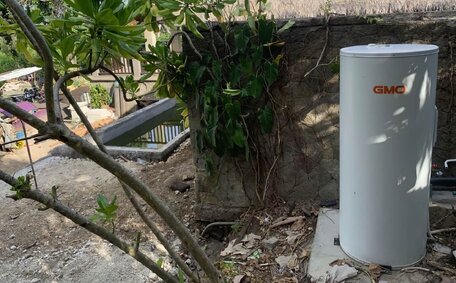
Financial Benefits of Natural Gas
Natural gas offers many financial perks over other energy sources. It burns cleaner and costs less than alternatives, helping lower monthly bills.
Read MoreThere are a few common causes of cloudy hot water:
Air bubbles, originating from within the water heating unit, are a common cause of cloudiness in hot water. When cold water enters the hot water system, it contains dissolved gases such as oxygen and sometimes methane gas, can cause a milky cloudy appearance in hot water upon heating. Heating the water induces the release of these gases as tiny air bubbles, which cause the cloudy, milky appearance.
Fluctuations in water pressure or in the pressure relief valve can trap more air in your tap water lines. This is more likely in winter when hot tap water temperatures are typically lower.
Hard water supplies contain dissolved minerals such as calcium and magnesium. As hot water flows through pipes and your water heater over time, these minerals can come out of solution and form deposits. Sediment from these minerals can cause cloudiness in your hot water.
In some cases, cloudy hot water may indicate issues with your water heater itself. Deterioration of the tank interior or components like the anode rod can cause sediment to enter the water supply. Consulting a plumber is essential for diagnosing issues related to your water heater.
Although inconvenient, cloudy hot water is usually harmless and typically becomes safe for consumption after waiting several minutes for the cloudiness to clear. But if after a few minutes you see the cloudiness persists or notice sediment, it’s best to engage a professional to resolve these plumbing concerns.
Cloudy hot water, generally due to harmless air bubbles, is usually safe for drinking. The cloudiness caused by air bubbles in your tap water is an aesthetic issue rather than a health hazard. As the bubbles ascend, the water should start to clear from the bottom and become transparent in a short time.
However, if you’re questioning why my hot water doesn’t clear up or has an unusual taste or grittiness, avoid drinking or cooking with it. Persistent cloudiness or sediment could potentially be caused by problems like:
In these situations, consider the safety of the water for consumption.
One might ask 'What does that cloudiness mean?' but, generally speaking, temporary cloudiness caused by air bubbles is harmless. However, you should exercise caution with persistent cloudiness and avoid using the water until the issue is identified and corrected.
To figure out what’s causing cloudy hot water, there are a few troubleshooting steps you can take:
To determine the cause of cloudiness, compare your hot and cold water streams. Cloudiness in only the hot water points to your water heater or hot water pipes as the likely cause. If both hot and cold are cloudy, the issue is probably prior to the hot water systems making your tap water cloudy.
Inspect sinks, tubs, and showers throughout your home, considering the water area of each level, for signs of cloudy tap water. If all faucets are delivering cloudy water, the problem likely lies within the local water mains or a widespread issue such as elevated sediment levels.
If only one or a few faucets are cloudy, there may be issues with your aerator or localized buildup in the pipes.
Observe if the cloudiness in your glass water dissipates, clarifying from the bottom up, within a few minutes to understand why your tap water might appear cloudy. If so, temporary air bubbles are likely why your tap water appears cloudy. But if you’re pondering 'why my tap water remains cloudy’, sediment or mineral buildup may be the issue.
Tracking down the specific faucets and conditions where you see cloudy water can help narrow down the cause and determine if professional repairs are needed.
Water pressure changes, as highlighted by your water supplier, commonly cause the air bubbles seen in hot water. The science behind this is straightforward:
Cold water comes into your home under pressure. As it travels through the pipes, the pressure forces additional air to dissolve into the water. This process creates invisible air bubbles in your cold water.
Yet when this cold water is heated in the water heater, the dissolved air materialises as tiny bubbles, causing the emerging water to appear cloudy.
Drops in water pressure can result in even more air bubbles trapped in the cold water before it journeys to the hot water heater. So when that extra air is released by heating, it creates a cloudier appearance than normal.
The same thing can happen in winter, when cold water temperatures are low and air is coming out your faucet. When water is colder, it holds more air than warm water when it comes to being dissolved in a liquid state. So as soon as it’s heated, all those air bubbles are released, causing cloudiness.
The good news is these air bubbles are harmless and the cloudy water also disappears, clearing from the bottom of the glass upward after a few minutes. If it doesn’t, there may be an issue with sediment in your pipes or water heater.
The water from your local supply, rich in dissolved minerals like calcium and magnesium, can contribute to water hardness. Sediment from minerals accumulating over time in your water heater tank, pipes, and fixtures is a likely source of cloudy hot water.
As hot hard water flows, it deposits these minerals on the interior surfaces. Pieces of this mineral scale can then break loose, causing cloudy water in your hot water.
Water softening systems are a great solution for preventing mineral buildup. They use a process called ion exchange to remove the excess calcium and magnesium ions that cause hardness.
Reverse osmosis filters, another form of water filtration, effectively remove minerals from the water supply. They force water through a semi-permeable membrane that traps dissolved solids like calcium and magnesium.
Reducing the mineral content of your water can help minimise scale buildup and sediment issues that contribute to cloudy hot water.
Over time, sediment can build up inside your hot water heater tank. Heating causes minerals in the water to settle and deposit on the tank walls. Chunks of this mineral scale eventually break loose, causing cloudiness.
The water heater’s sacrificial anode rod, which protects the tank from corrosion, also slowly disintegrates. Pieces of the anode entering the water supply can result in cloudy hot water.
To reduce sediment issues, a periodic flush of the water heater can also remove some of this buildup.
Frequent cloudiness, however, may suggest a failing anode rod.
Enhancing your water’s quality and performing preventative maintenance, like regular anode rod inspections, can extend the lifespan of your hot water system.
There are several steps you can take to troubleshoot and resolve cloudy hot water:
Draining and flushing the water heater can help clear out sediment that may have built up over time. This involves turning off the power supply, attaching a hose to the drain valve, and flushing out a few gallons.
Hard water is a major cause of cloudiness in your system due to mineral deposits coming out of solution. Installing a water softener that removes calcium and magnesium ions can prevent this.
If your water heater has a corroded or failing anode rod, pieces of it can break off and cause cloudy water.
Routine professional water heater maintenance checks for sediment buildup, corrosion, and faulty components that could contribute to cloudy water issues.
Addressing persistent cloudiness or sediment may require the replacement of your water heater at times. Upgrading to a new more efficient model can provide hot water clarity.
Following these steps can help diagnose and resolve common causes of cloudy hot water problems.
Flushing your water heater periodically helps remove sediment buildup and maintain efficiency. Follow these steps for a DIY flush:
For severe sediment buildup, a professional flush may be needed. But periodic DIY flushes can help maximise your water heater’s lifespan.
Hard water wreaks havoc on plumbing systems and appliances. The high mineral content leads to scale buildup that reduces efficiency and shortens the lifespan of water heaters, pipes, and more. A water softener is the solution to these hard water problems.
Water softeners use a process called ion exchange to remove the calcium and magnesium ions that cause water hardness. Inside the tank are small resin beads that attract and latch onto the calcium and magnesium ions as water passes through. The ions are replaced with sodium or potassium ions, leaving your water soft.
To prevent cloudy water in your taps, you’ll need to consider these key steps to install a water softener:
Pick a spot with easy access to water supply lines, drain lines for flushing, and an electrical outlet. Minimise long runs of plumbing. Basements or garages are ideal locations.
Turn off the main water supply and cut into the hot water lines. Install a bypass valve to control water flow during servicing. Make sure inlet and outlet arrows point the right direction.
Use flexible stainless steel hoses to connect the bypass assembly to the softener inlet and outlet. Run a drain line from the softener to a floor drain or outdoors.
Pour resin beads into the mineral tank, then add salt to the brine tank, which will eventually produce soft out water after the treatment process. Salt levels must be maintained for continuous softening capability.
Set the grain hardness, time of regeneration, and other preferences per the user manual. This optimises softening performance.
Once installed, regularly clean and recharge the resin beads to maintain peak functionality. With proper maintenance, your water softener will provide years of scale prevention and help appliances run more efficiently.
The anode rod is a crucial component inside your water heater tank. This rod attracts corrosion away from the tank itself, essentially sacrificing itself to extend the life of the heater. Yet over time, the corroding anode rod may release bits of metal that cause hot water cloudiness.
Signs that your anode rod needs replacing include:
To replace your anode rod, start by turning off the power to the water heater and closing the water supply lines. Use a socket wrench to unscrew the old anode rod and install a new one, making sure to use pipe thread sealant. Refill the tank, restore power and water supply, and turn on a hot water faucet to flush any sediment.
Then, to address cloudy tap water issues, partially drain the tank.
Periodically checking and replacing your anode rod allows it to effectively protect your water heater from corrosion. This prevents tank degradation and breakdown of the anode that causes cloudy or discoloured hot water.
While many causes of cloudy hot water are harmless and can be addressed with DIY troubleshooting, certain situations warrant contacting a licenced plumber for inspection and repairs.
If flushing your water heater, installing a water softener, or replacing the anode rod fail to resolve persistent cloudiness or sediment, professional expertise may be required. Sediment buildup could stem from pipe corrosion, mineral deposits, or a deteriorating tank lining. A pro can run diagnostics to pinpoint the underlying issue.
Likewise, questioning why my hot water is cloudy and if the issue is isolated to only your hot water, your water heater or hot water pipes likely need servicing that a plumber is best equipped for. They can check components like heating elements, thermostats, and valves.
It’s also wise to call a plumber if you have concerns about potential water contamination or notice an unusual taste, smell, or grittiness to your hot water. This may indicate corrosion or bacteria that require thorough inspection and water testing.
For residents of Gold Coast, depend on your local plumber, the licenced professionals at Gold Coast Plumbing. With expertise in all water systems, they can quickly diagnose your cloudy water causes and restore hot water clarity. Contact them via phone, email, or request an appointment.
You might be pondering what can be done regarding several effective methods to prevent cloudy or discoloured tap water:
Periodically drain and flush your water heater to remove sediment buildup. Do this every 6-12 months to maximise efficiency.
Water softeners remove excess mineral content that can cause scale accumulation in hot water pipes and heaters. Reducing hardness minerals minimises this sediment issue.
Inspect the anode rod every 2-3 years and replace if corroded. This prevents it breaking down and releasing particles into the water.
Ensuring hot water pipes are properly insulated prevents temperature fluctuations that contribute to air bubble formation.
Have a professional inspect and service the water heater every 1-2 years to identify potential problems before they cause cloudy water.
Making cloudy water prevention part of your regular plumbing maintenance helps optimise hot water quality and clarity.
Natural gas offers many financial perks over other energy sources. It burns cleaner and costs less than alternatives, helping lower monthly bills.
Read MoreChoosing the correct hot water system size involves considering factors like number of household members, number of bathrooms, peak usage times and daily hot water needs per person. Our guide helps determine the right system capacity.
Read MoreHaving trouble with your gas water heater not heating properly? The pilot light may have gone out. Follow our clear guide on relighting your gas water heater’s pilot light in 6 easy steps. Or call the friendly experts at Balmain Plumbing if you need assistance relighting your pilot.
Read MoreBalmain, 2041 NSW
We will call back as soon as possible.




